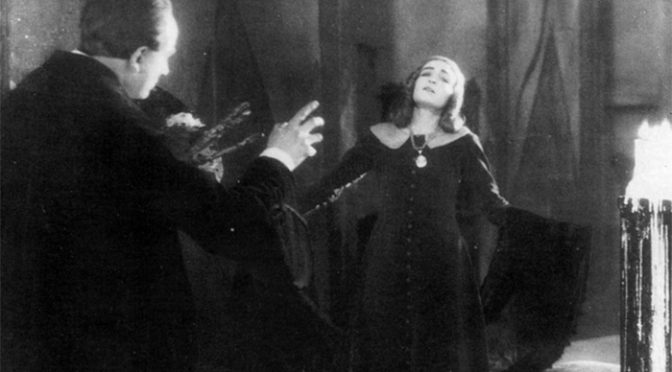The main event at this performance, part of the Festival’s ‘Restorations and Rediscoveries’ strand, was Jean Epstein’s hour-long silent LA CHUTE DE LA MAISON USHER (THE FALL OF THE HOUSE OF USHER) from 1928. It was preceded by Jan Svankmajer’s THE PENDULUM, THE PIT AND HOPE (KYVADLO, JÁMA A NADEJE), a live action short with flashes of the director’s trademark stop-motion animation.
Svankmajer’s vision of mechanised, literally inhuman implements of torture is reminiscent of Kafka…
Though both reference Edgar Allan Poe’s work in their titles and subject matter, Epstein’s film never matches the sheer nastiness of Svankmajer’s short. Epstein leans heavily on the romantic fatalism of Poe’s French translator Baudelaire, while Svankmajer’s vision of mechanised, literally inhuman implements of torture, whose inventive cruelty awakens a corresponding inventiveness in the film’s unseen protagonist, is reminiscent of the director’s Czech compatriot Kafka. Made in 1983, Svankmajer’s film was reportedly banned by the Communist authorities of the time, who saw through the superficial anti-clericalism of the film’s setting and recognised themselves in the authority figures who, believing themselves benevolent, nonetheless mete out terrible punishment to those who think differently.
By all accounts, the director co-wrote USHER with the young Luis Buñuel, who left the production prematurely. It begins much like Poe’s story — Sir Roderick Usher (Jean Debucourt), the last of this ancient line, is visited by an old friend (Charles Lamy), who finds him horribly distracted and the house in disarray — and in some respects it follows the original narrative very closely. The main change involves Madeline (Marguerite Gance), the lone female in the film: in Poe’s version she is Roderick’s beloved sister, whereas now she is his wife. In both versions she is dying, but Epstein’s film adds the embellishment of directly relating Madeline’s sickness to Roderick’s obsessive painting of her, as if the portrait is sapping her life-force. (Epstein has the portrait blink every so often, which suggests that this is exactly what is happening.)
Epstein combines various forms of artifice to give the world of the film a disorienting, off-kilter feel…
The film is a marvel of technique. Epstein combines various forms of artifice — stylised production and costume design, highly mannered performances, strange camera angles, superimposition and slow-motion sequences — in an effort to build atmosphere and give the world of the film a disorienting, off-kilter feel. Ironically, perhaps, the very success of this approach gives the film a somewhat over-determined feel, and while it occasionally achieves the vivid delirium of a nightmare, it is not quite the sublimely uncanny experience its director was surely aiming for.
For all that, the film is pleasingly creepy and never less than intriguing, and it is difficult to imagine a more committed or effective advocate of it than the pianist at this performance, Stephen Horne, whose all-important sonic accompaniment went well beyond usual expectations. Often augmenting his piano with a variety of other instruments, including flute, accordion and an array of bells, Horne matched the action of the film with an imaginative precision. The only disadvantage of Horne’s box of tricks was that it may have been too distracting, tempting the viewer to look away from the screen to see how a particular aural effect was achieved.

